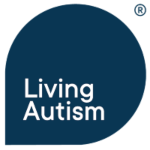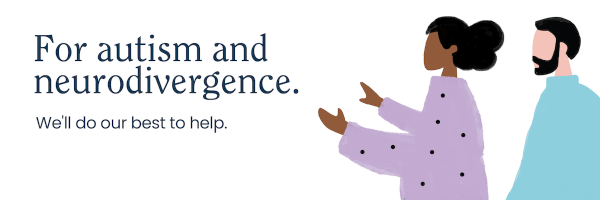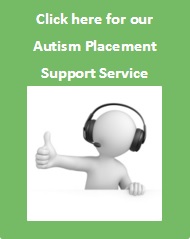Much has been written for the attention of the clinical community about the forthcoming (May, 2013) Diagnostic and Statistical Manual of Mental Disorders, version five (DSM-5) and the changes to the way in which autism per se will be classified for diagnostic purposes. The most controversial proposal is to amalgamate the various sub-types of autism into the omnibus diagnostic category of Autism Spectrum Disorder (ASD), removing Asperger’s Syndrome (AS) and PDD-NOS from the scientific lexicon; but what will this mean to the lay-person, the Mother/Father of a un-yet diagnosed child, and furthermore, what will it mean to an already diagnosed autistic individual? As a mother (son with Asperger’s) and as a professional (CEO of Action for Asperger’s charity), I wanted to find out.
As the holder of a Master’s in Autism and PGC in Asperger’s Syndrome, one might think that I would be qualified enough to diagnose a person with autism, but as my qualifications are non-clinical, technically I cannot diagnose. As a non-clinician I can only ‘assess’ a person to see if I think autism is a distinct feature of their atypical neurology. Whether this is right or wrong is a matter perhaps for debate, but it is commonly accepted in the UK that a clinician’s diagnosis is of legitimate value…
Consider the recent positive outcome of the Gary McKinnon case…would Gary have had such a favourable outcome without the likes of Professor Simon Baron-Cohen and other equally outstanding qualified clinical professionals proffered clinical opinions stating categorically his Asperger’s Syndrome status? I doubt it. One of my pet hates is that there exist people working in the autism field who purport to ‘diagnose’ when all they can do legitimately is ‘assess‘ and this, to my mind, is mis-selling to vulnerable people in society: caveat emptor ‘let the buyer beware’ is my earnest advice to any person thinking in this direction presently. An official (clinical) diagnosis is deemed necessary for a number of reasons, some of which include:
- Better access to disabled services by registering with the Department of Work and Pensions (DWP) as disabled.
- Improved conditions in an educational setting eg. Educational statementing and Individual Education Plans (IEPs).
- Improved employment conditions as diagnosis leads to support/protection under The Autism Act 2009.
- Improved sense of ‘self’ as individual seeks to understand his/herself better.
Diagnosis involves ‘tick-boxing’ the criteria for diagnosis that is in the DSM, (presently the DSM-IV est. 1994) also commonly referred to as ‘the bible of psychiatry’. The DSM was created by clinicians for clinicians, and is referred to regularly by psychiatrists and clinical psychologists alike who seek to reference patients against a checklist of behaviours; it is a book not intended for any other professions, although other professions may be able to access it for reference purposes. The process of checklisting a patient against the DSM criteria creates a significant clinical marker for autism and is especially important in the absence of a biological test to determine autism. The DSM-IV is 886 pages large, and is a document that has been peer-reviewed by the American Psychiatric Association, also a governing body.
The DSM-IV is specific as to specifying the more severe and milder sub-types of autism such as Asperger’s Syndrome and Savant Syndrome. The DSM-IV refers to the basic triad of problems: impaired social communication, impaired social interaction and restricted behaviour patterns. What is set to change in the new DSM-5 is that the various sub-types of autism will be amalgamated into the omnibus diagnostic category of Autism Spectrum Disorder (ASD) and the triad becomes a dyad, with impaired social communication and impaired interaction being classified as one conjoined problem and restricted behaviour.
Professor Franscesa Happé, a member of the DSM-5 Neurodevelopmental Disorders Workgroup said that one of the reasons for the change was ‘to date there is not a robust, replicated body of evidence to support the diagnostic distinction’ (between the various categories). Some clinicians have found that distinctions among the spectrum disorders to be inconsistent over time, variable across sites and have tended to be associated with severity, language, and intelligence rather than features of the disorder. In addition, there is the belief among many that a single spectrum disorder will provide a better reflection of the clinical presentation and pathology.
The removal of Asperger’s Syndrome and Pervasive Development Disorder – Not Otherwise Specified (PDD-NOS) from the DSM-5 will mean for some:
- That AS & PDD-NOS individuals fear losing their identities.
- That a unified diagnosis will create a shift in focus on to their social impairment, and that this will overshadow and consequently underestimate their intellectual capabilities
- AS individuals and connected-others perceive there to be little or no stigma attached to their syndromes, whereas autism tends to conjure up more negative and stereotyped connotations. This may, in turn, deter people from seeking a diagnosis, due to an aversion to an ‘autism’ label and similarly, on a global level may prevent future generations from getting help – the knock-on effect of this would be that autism trends will be difficult to analyse and project…trends in autism rates which are critical in planning medical and educational services in the future.
- A sense of mourning; AS is now 19 years old according to the DSM, and has reached the ears, hearts and minds of many, whom, pre-1994, were unaware of the Syndrome’s existence and for many there is an uneasy sense of having to un-learn it.
- There is fear concerning the future provision of welfare benefits like the Disability Living Allowance (DLA) as current recipients query if it will still be obtainable under the new diagnostic classifiers.
- The DSM-5 plans to classify autism as a series of deficits in overt typical behaviour and will rank and classify all autistics according to a rigid hierarchy of severity.
The new name – Autism Spectrum Disorder (a single diagnostic category), will include:
- Autistic Spectrum Disorder
- Asperger’s Disorder
- Childhood Disintegrative Disorder
- PDD-NOS
The DSM-5 will mean that the triad of impairments, becomes a dyad of impairments:
- Social and communication deficits are now regarded as one, not two, because they have been deemed inseparable.
- Fixated interests and repetitive behaviours will include unusual sensory behaviours.
Then there is the ‘severity’ level which has to be considered and recorded. Level 1 is ‘requiring support’, with Level 2 ‘requiring substantial support’ and finally, Level 3 ‘requiring very substantial support’. For example: Level 1 Social Communication talks about deficits in social communication causing noticeable impairments, with difficulty initiating social interactions with unsuccessful or atypical responses to the social overtures of others, and in the higher level, Level 3, a reference is made to ‘severe’ deficits in verbal and nonverbal social communication, causing severe impairments in functioning. For ‘Restricted Interests and Repetitive Behaviours’, classification ranges from Level 1 whereby reference is made to rituals and repetitive behaviours causing significant interference with functioning in one or more contexts, with resistance to interruption or redirection from their fixated interest by others, to Level 3, which states that preoccupations, fixated rituals and/or repetitive behaviours ‘markedly’ interfere with functioning in all spheres, along with ‘marked’ distress when rituals or routines are interrupted and difficulty in being redirected from the fixated interest, or, returning to it quickly.
The changes are not wholly favoured by all clinicians: Wing, Gould and Gilberg (2011) state ‘we believe that the DSM committee has overlooked a number of important issues, including social imagination, diagnosis in infancy and adulthood, and the possibility that girls and women with autism may continue to go unrecognised or misdiagnosed under the new manual’. I agree with Wing, Gould and Gilberg’s concerns, but on the other hand I also concur with what Rowland Barrett, PhD and Gregory K. Fritz, MD, have to say and that is ‘ the expansion of autism into a unified ASD category is likely to provide more diagnostic room for minimally affected children. It may achieve its intended effect of decreasing false positive associated with a diagnosis of Asperger’s; however it may also expand the boundaries for inclusion of children with ‘PDD-ish’ behaviour who, currently, we are reluctant to label’.
My own opinion is that the DSM-5 changes reflect in a similar fashion the way I have personally always defined autism. When explaining autism to my clients, I draw a Likert scale to illustrate the broadness of the spectrum, with 0-5 indicating below average to average intelligence and 5-10 indicating the average to above average intelligence range. In the 5-10 range, I place the HFAs, Asperger’s Syndrome and Savant individuals, while in the 0-5 I would place the Kanner’s autists. The Likert scale I refer to as Autism Spectrum Conditions (I cannot and will not call it ASD-Autism Spectrum Disorder; I have way too much respect for anyone with autism syndrome to refer to them as ‘disordered’) and stress its width and depth. While the DSM-5 is seen by some as an effort to rank and classify all autistics according to a rigid hierarchy of severity, the DSM-IV has encouraged what I refer to as ‘autism snobbery’: I have stood on the sidelines of many a conversation where a Mother explains her autistic son’s persona to another autistic child’s parent, only to be met with a response of ‘my son only has mild autism unlike your son, and therefore we have nothing in common…‘ or ‘my daughter is very clever…she is a HFA, and nothing at all like your Kanner’s autistic daughter‘, as if it makes autism acceptable if one’s son or daughter is not ticking, stimming, or rocking, but is instead researching molecular activity at Harvard.
My suspicion, based on experience and knowledge, is that despite a proposed abolition of the diagnostic category of Asperger’s Syndrome, clinicians will find it difficult to remove the term altogether; that Hans Asperger’s mark has been firmly made since it’s introduction in the DSM-IV in 1994 and that it will stay, and clinicians will use phrases like ‘autism of the Asperger’s variety’. I, for one, have built a charity on Asperger’s name and the syndrome he discovered, and therefore am opting not to change a single thing in terms of the way my counselling model operates within that setting. The only thing I am determined to change however is the way people refer to autism as a disorder, preferring instead to call autism a ‘condition’, and that, my reader, is ‘all I have to say about that!’ except to state also that the Roman numeral ‘IV’ has been replaced by the number ‘5’ for modern search engine purposes apparently; and in this modern technological age, that’s a change we can all live with!
Elaine Nicholson, MA Autism, PGC Asperger’s Syndrome, Cert (Merit) Counselling, DMS
Action for Asperger’s
Registered Charity 1148790



